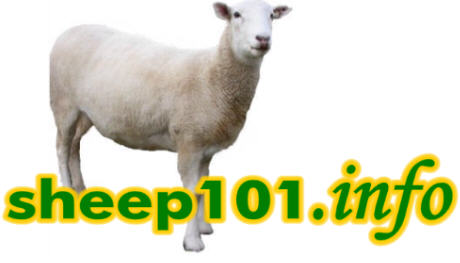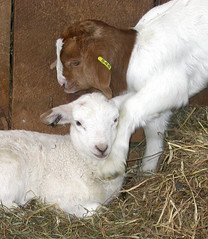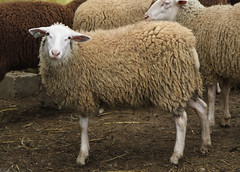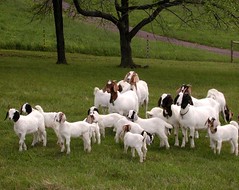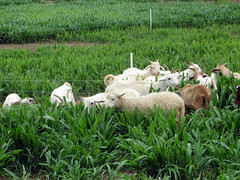Sheep and goat production
Reproduction
There are a few differences in the reproductive systems of sheep and goats. The estrus (heat) cycle of the ewe averages 17 days while the doe's estrus cycle averages 21 days. Goats are much easier to artificially inseminate (AI)
than sheep. There are several reasons why.
Ewes have a more complicated cervix which makes passage
of an insemination rod very difficult. When artificially breeding ewes, frozen semen is usually delivered laparoscopically into the uterine horns. Sheep show few visible
signs of estrus as compared to goats. A teaser ram is required to detect estrus or timed inseminations are done after hormonal manipulation.
Though it varies by breed, goats tend to be less seasonal and
more prolific than sheep. Male goats have an
offensive odor during the mating season; rams do not. The mating rituals of the two species vary, with goats being more demonstrative in their behavior.
Nutrition
Sheep and goats have similar nutrient requirements, though goats
have higher maintenance requirements because they are not able to digest the cellulose of plant cell walls as well as sheep. Lambs tend to grow much faster than
kids, no matter what the diet is. Sheep convert feed more efficiently.
Grain-feeding is less likely to be profitable in goat (meat) production.
With the exception of a few breeds, sheep and goats fatten very
differently. Goats deposit fat around their internal organs before
depositing external fat over their back, ribs, and loin. Sheep deposit external fat before depositing
internal fat. Finn sheep and hair sheep of tropical orgins deposit fat
around their organs similarly to goats.
Both species require copper in their diet, but with sheep there is a narrow margin between requirements and toxic levels, though toxic levels depend upon the level of other minerals in their diets. Breeds also vary in their sensitivity to copper toxicity. For this reason, it is generally recommended that sheep
not be fed grain and mineral mixes that have been formulated
for other livestock (including goats), as these feeds likely have copper added to them.
It can also be risky to graze sheep on pastures that have been
fertilized with poultry or hog manure. Caution should be exercised when using any form of copper as a deworming agent. Additional copper should not be added to the diet of sheep unless a deficiency is confirmed by laboratory tests.
Goats require more copper
in their diets than sheep and are not as sensitive to copper toxicity.
Their maximum level of copper is considered to be similar to cattle. When co-mingled, sheep products should be fed. It may be necessary to give copper supplements to goats that are co-raised with sheep.
Diseases
Sheep and goats are generally susceptible to the same diseases,
including scrapie, which is transmitted via infected placenta
to genetically-susceptible offspring. U.S. law requires both species to carry official USDA identification when entering commerce or moving from the farm of origin.
Sheep and goats are infected
by the same internal parasites (worms), though coccidia (Eimeria spp.) tend to be host-specific. Both sheep and goats can serve as a abnormal host for meningeal worm, a parasite of white tail deer.
Goats tend to be more susceptible to worms than sheep, due to
their origins (in a dry climate) and natural browsing behavior. They are slower to develop immunity (to parasites). Goats also metabolize
dewormers more quickly and require higher doses of the drugs. The
clostridial vaccines seem to be less effective in goats than sheep.
Tissue reactions (to vaccinations) tend to be more common in goats than sheep. Fewer drugs are FDA-approved for use in goats.
OPP (ovine progressive pneumonia) and CAE (caprine arthritic encephalitis),
are similar diseases, caused by a slow virus (like HIV), that affect
sheep and goats, respectively. CAE is transmitted mostly via colostrum, whereas OPP is mostly the result of lateral transfer (animal to animal, usually mature females to replacement ewe lambs).Cross infection is possible.
No disease similar to "floppy kid syndrome" has been diagnosed in sheep.
Social dominance
Due to their more aggressive behavior, goats will usually dominate
sheep, especially if the goats have horns and the sheep are polled (hornless). However, when young
bucks and rams are maintained together, rams will dominate because
the ram will preemptively strike the buck in the abdomen while
the buck is still in the act of rearing up.
<== ABOUT SHEEP
